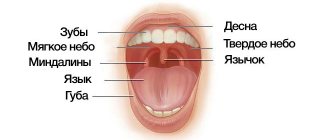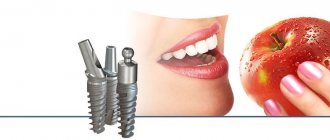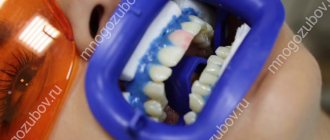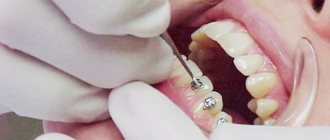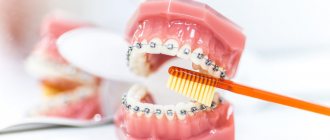Advantages of the method
Let's start with the fact that restoration of anterior teeth is always performed using light-curing materials. Accordingly, they will be applied in layers. When restoring teeth when they are completely destroyed, all kinds of rings and plates are used. It is the latter that are selected according to size and installed between the teeth.
But it may also turn out that there are teeth nearby that also need to be restored. In such a situation, the doctor may suggest filling them at the same time. At the same time, he does not use plates and, accordingly, there will be no gap between the teeth. What are the advantages in this case?
At first glance, food will no longer get stuck between the teeth. Of course this is an important advantage. But please note that food can also get into the microscopic gap in the root area. You won’t be able to remove it from there, which means the risk of inflammation increases.
Another advantage is that the process of restoring a tooth without forming a gap is simpler. It takes less time. Of course, the appearance of the teeth will not differ from natural ones. It’s just that in the area of the gap there will be not a gap, but a depression.
Preservation of the tooth socket or preservation of the natural contours of the alveolar process
According to antiplagiat.ru, the uniqueness of the text as of October 16, 2018 is 90.3%.
Key words, tags: tooth extraction, wisdom tooth, bone tissue, implant installation, augmentation, implantation.
Despite the rapid development of modern dentistry, tooth extraction is still a very common operation. When a doctor removes a tooth, be it a dystopic wisdom tooth or a severely rotted molar, in its place there remains a hole, a cavity, which is called the alveolar socket.
Previously, the affected tooth was simply removed, and the resulting cavity, the socket, healed on its own, with a significant decrease in bone tissue. But today, when talking about qualified dental care, we should talk about preserving the alveoli in its original state, even in the absence of a tooth.
Anatomy of the alveolar process
The alveolar, or dental, process (from Latin - processus alveolaris) is the part of the upper and lower jaws that extends from their bodies and contains teeth. The development and normal functioning of this structure is ensured by the roots of the teeth located in it.
The alveolar process appears only after teeth erupt and almost completely disappears with their loss. After a tooth is removed, the corresponding area undergoes resorption (resorption).
Dental alveoli, or sockets, are individual cells of the alveolar process in which teeth are located.
They are separated from each other by bony interdental (interalveolar) partitions. Inside the alveoli of multi-rooted teeth there are also internal (intra-alveolar) interradicular septa, which extend from the bottom of the alveoli and divide the alveoli into chambers (according to the number of roots).
The alveolar socket of the tooth has clear, defined boundaries, and it has all the conditions for bone regeneration; you just need to help it maintain its contour.
Hole preservation procedure
Preservation of the socket of an extracted tooth is a fairly simple and effective operation for preserving bone volume and maximizing the preservation of the natural contours of the alveolar socket. This surgical procedure is performed under local anesthesia and does not pose any risk.
Usually the operation is carried out in several stages:
- treatment of the hole after tooth extraction with special antiseptic compounds;
- installation of a membrane to protect the vestibular wall;
- filling the socket cavity with granular bone-forming substance;
- fixation of the operating surface by tensioning the free edges of the connective tissue;
- applying a bandage or a thin, neat suture.
Complete healing of the postoperative area occurs by the fourth week, and after 3–4 months, in some cases 6 months, if the condition is satisfactory, this area can be used to install an implant.
Treatment quality criteria
The main criterion for the quality of an alveolar socket preservation operation is its independent complete healing and maximum preservation of bone tissue, preservation of the natural contour and volume of the alveolar ridge, improvement of the condition of soft tissues and simplification of further stages of treatment.
If the operation is successful, there will be enough bone tissue in the socket to install a dental implant.
Separately, it is worth highlighting the advantages of condomization for the doctor and the patient - this is improved long-term treatment results, more predictable aesthetics and, of course, saving time for the doctor and the patient.
Indications for condom
Preservation of the socket of an extracted tooth is indicated for everyone who in the future wants to install a dental implant in its place. The process of loss and resorption of the jaw bone at the site of the extracted tooth begins immediately after the operation.
In the first year, bone tissue resorption will be 25% in volume, and over the next 3 years the loss in width will be 40 - 60%. In the case of socket preservation after tooth extraction, a larger volume of bone tissue in the jaw and the most natural contours of the alveolar process are preserved.
And then, subsequently, the likelihood of such a complex operation as alveolar bone augmentation when installing an implant will most likely not be required.
Contraindications
Preservation surgery is subject to the same restrictions as any osteoplastic surgery. Separately, I would like to note that it is not recommended to preserve a hole after tooth extraction in a state of acute pain, since the risk of complications increases.
But in each specific clinical case, the actions of a professional dentist are strictly individual. Sometimes situations arise when you have to take risks, but this is due solely to medical indications.
In any case, it is necessary to understand that performing a tooth extraction operation and subsequent preservation on a planned basis is better than as part of emergency care.
Restrictions
It is logical to perform a preservation operation after the removal of permanent molars, within the so-called sevens, second molars (except for wisdom teeth, eights), since when baby teeth fall out, bone tissue does not resorption. There is no upper age limit for performing an operation aimed at preserving the natural contours of the alveolar process.
Disadvantages of the technique
Notice that each tooth moves separately as you chew. These fluctuations are not visible to the eye. But if you bind two adjacent teeth with material, this can cause pain while chewing food. This is one of the reasons why the teeth need to be made separately and not tied together.
The downside is that the gap between the teeth needs to be cleaned. You won't be able to do this with thread. A natural option is an irrigator, but you need to know how to use it.
Thus, we found out that the gap between the teeth is important not only from an aesthetics point of view, but also from a physiological point of view. You should not agree to restore teeth using this method. Moreover, today there are a lot of devices that allow you to restore a tooth with a perfectly smooth contact surface. Here you will no longer have difficulty cleaning and removing food debris.
Removing tooth roots using a drill
It is sometimes impossible to remove the tooth root or part of it remaining in the socket with forceps and elevators. More often this happens when, during tooth extraction or injury, a fracture of the apical part of the root occurs, and all attempts to extract it from the depths of the hole using the methods described above are unsuccessful. Often the root cannot be removed due to its significant curvature, hypercementosis or anomaly in shape and position, as well as when it is located deep in the alveolar process and is completely covered with bone and mucous membrane. In these cases, a root cutting operation is performed, which involves removing the outer wall of the hole with a bur. After this, the root can be easily removed with forceps or an elevator. Root cutting is more labor intensive than regular tooth extraction and is performed as an assisted operation. A sterile cover is put on the sleeve of the drill, after which the doctor attaches a straight tip treated with alcohol or boiled in oil.
It is more convenient to carry out the operation in a semi-lying position with the patient's head slightly reclined and turned towards the surgeon. After anesthesia has been performed, surgery begins. The assistant pulls back the lip and cheek with a blunt hook, creating free access to the surgical field. The operation begins with a trapezoidal or arcuate incision in the mucous membrane and periosteum on the outside of the alveolar process (Fig. 6.19, a). The incision should cover the area of adjacent teeth so that the formed flap with its edges overlaps the wall of the socket removed during the operation on both sides by 0.5-1 cm. An angled incision can be made on the lower jaw. With this incision it is easier to suture the wound. After dissection of the tissue, the mucoperiosteal flap is peeled away from the bone using a small rasp or a smoothing iron. The separation of the flap begins from the gingival edge along its entire length. At the edge it is tightly fused to the bone and comes off with difficulty; closer to the transitional fold it comes off easily. The assistant, using a blunt serrated or flat hook, pulls and holds the separated flap.
Having exposed the outer surface of the alveolar process, they begin to remove the wall of the socket using a fissure bur with cooling. If the root is located deep in the hole, then a significant part of it can be removed with bone nippers or forceps with narrow converging cheeks. The remaining part of the bone is also smoothed with cooling using a sharp fissure or spherical bur. The root is removed with forceps or an elevator. In case of a deep fracture of the roots, as well as their curvature, hypercementosis and other anomalies, the outer wall of the alveoli is removed to the very apex of the root. In such cases, it is especially important to use cooling when drilling into the bone to prevent overheating of the bone. Having exposed the root from the outside, a small gap is sawed with a bur between it and the side wall of the hole. By inserting a straight elevator into it and leaning on the wall of the hole, the root is dislocated using a lever-like movement. A small broken-off part of the root apex can often be removed from the bottom of the socket using a float, a curettage spoon, a special screw, a metal ligature (see Fig. 6.17) or a scaling instrument.
When removing the thick outer compact layer of bone from the lower molars, a different technique is used. A small spherical or cone-shaped bur is used to drill a series of holes in the outer wall of the alveolar part of the jaw along the periphery of the area of bone to be removed (Fig. 6.19, b). Then they are connected to each other with a fissure bur (Fig. 6.19, c); The cut section of the bone is easily separated using an elevator or a narrow rasp. The final separation of the roots from the bone covering them is carried out with burs. If the inter-root bridge is preserved, it is sawed with a fissure bur. Using an angular elevator, first one of the roots is dislocated, and then the second root (Fig. 6.19, d, e). When removing the palatal root of the upper molars and the first small molar, a mucoperiosteal flap is cut out and folded back from the vestibule of the oral cavity. First, the buccal roots are exposed and removed. Then, bone cutters and burs are used to remove the bony septum between the buccal and palatal roots. After this, it is not difficult to remove the palatal root using a straight elevator or bayonet-shaped forceps with narrow cheeks.
After extracting the root from the hole, granulation tissue, small bone fragments and sawdust are removed from it using a sharp surgical spoon. A milling cutter is used to smooth out the sharp edges of the bone. At the end of the surgical intervention, the wound is treated with a 3% hydrogen peroxide solution and dried with tampons. When removing a tooth by sawing, you should be very careful with the resulting bone filings. They are collected in a sterile porcelain mortar or glass jar and filled with a sterile isotonic sodium chloride solution. Collecting bone chips using a “bone trap” is especially effective. Bone filings are mixed with demineralized bone in the form of granules or sawdust, hydroxyapatite, as well as other types of synthetic bone and xenotissues. This mass is placed in the alveolus of a tooth or a bone defect formed after working with a bur, the biomaterial is compacted tightly, mixing it with blood. The detached mucoperiosteal flap is placed in place and secured with sutures made of catgut (preferably chrome-plated) and polyamide thread (Fig. 6.19, e). Bone plastic surgery after tooth extraction, especially a complex one, prevents bone atrophy and creates better conditions for subsequent prosthetics. If there is not enough soft tissue to deeply close the wound, a small strip of gauze soaked in an iodoform mixture or a hemostatic sponge soaked in gentamicin, a block of kolapol or kollapan containing antibiotics, an anesthetic and anti-inflammatory drug “Alvo-gyl” should be loosely inserted into the hole. On the first day, analgesics are prescribed.
Did you like the article? Share with friends
0
Similar articles
Next articles
- Wound healing after tooth extraction
- Accurate impressions using Panasil film and materials - fast and stress-free
- Sandwich technique in restoration technology with ceramic veneers
- Jazz polishing system
Previous articles
- Removal of tooth roots and teeth using elevators
- Means for effective local prevention of dental caries
- Laser teeth whitening
- Microbiological evaluation of photoactivated disinfection in endodontics
- Application of laser in dentistry
